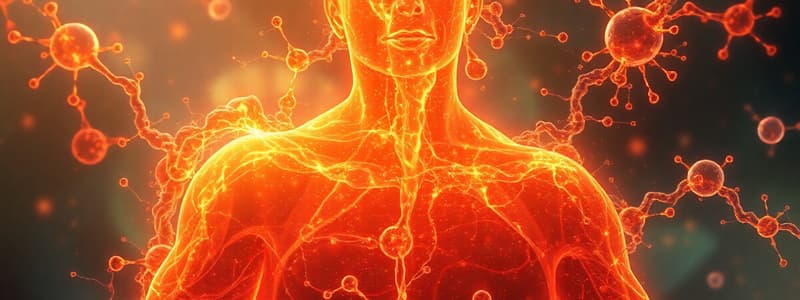Podcast
Questions and Answers
Which condition is most commonly related to excessive insulin production, potentially causing hypoglycaemia?
Which condition is most commonly related to excessive insulin production, potentially causing hypoglycaemia?
- Calcitonin-secreting tumours
- Insulinoma (correct)
- Carcinoid syndrome
- Hypopituitarism
What is a potential cause of hypoinsulinaemic hypoglycaemia?
What is a potential cause of hypoinsulinaemic hypoglycaemia?
- Insulin receptor antibodies
- Primary hyperaldosteronism
- Severe liver disease (correct)
- Adrenal hyperplasia
Which of the following conditions might result in elevated C-peptide levels during hypoglycaemia?
Which of the following conditions might result in elevated C-peptide levels during hypoglycaemia?
- Insulinoma (correct)
- Alcohol-induced hypoglycaemia
- End-stage renal disease
- Accidental insulin overdose
What signifies the presence of insulin receptor antibodies in a hypoglycaemia patient?
What signifies the presence of insulin receptor antibodies in a hypoglycaemia patient?
Which condition is NOT associated with reactive hypoglycaemia?
Which condition is NOT associated with reactive hypoglycaemia?
What is the primary metabolic priority during starvation?
What is the primary metabolic priority during starvation?
How long can a human survive without food under dehydration conditions?
How long can a human survive without food under dehydration conditions?
What nutrient provides the largest energy reserve in a well-nourished 70 kg man?
What nutrient provides the largest energy reserve in a well-nourished 70 kg man?
Which process contributes the least to glucose production during prolonged starvation?
Which process contributes the least to glucose production during prolonged starvation?
What happens to blood glucose levels during the first day of starvation?
What happens to blood glucose levels during the first day of starvation?
How long can glycogen reserves typically last during starvation?
How long can glycogen reserves typically last during starvation?
What metabolic change occurs in response to low blood glucose during starvation?
What metabolic change occurs in response to low blood glucose during starvation?
Which amino acids serve as a source of glucose during starvation?
Which amino acids serve as a source of glucose during starvation?
What is the main strategy to preserve protein during starvation?
What is the main strategy to preserve protein during starvation?
What is the primary reason for the accumulation of lactate in the blood during conditions of tissue hypoxia?
What is the primary reason for the accumulation of lactate in the blood during conditions of tissue hypoxia?
Which physiological process primarily occurs in the liver to convert lactate back into glucose?
Which physiological process primarily occurs in the liver to convert lactate back into glucose?
Why is anaerobic glycolysis particularly favored during high-intensity physical activity?
Why is anaerobic glycolysis particularly favored during high-intensity physical activity?
Which of the following factors can lead to pathological lactic acidosis?
Which of the following factors can lead to pathological lactic acidosis?
What happens to lactate production under aerobic conditions compared to anaerobic conditions?
What happens to lactate production under aerobic conditions compared to anaerobic conditions?
Which statement best describes the role of adrenalin during muscular contraction?
Which statement best describes the role of adrenalin during muscular contraction?
When lactate accumulates in the blood during shock syndrome, what is primarily affected in the body’s metabolic pathways?
When lactate accumulates in the blood during shock syndrome, what is primarily affected in the body’s metabolic pathways?
What is the fasting plasma glucose concentration that indicates a diagnosis of diabetes mellitus?
What is the fasting plasma glucose concentration that indicates a diagnosis of diabetes mellitus?
Which condition does NOT affect the use of HbA1c for diagnosing diabetes?
Which condition does NOT affect the use of HbA1c for diagnosing diabetes?
What is the threshold plasma glucose concentration for diagnosing hypoglycaemia?
What is the threshold plasma glucose concentration for diagnosing hypoglycaemia?
Which of the following symptoms is NOT typically associated with hypoglycaemia?
Which of the following symptoms is NOT typically associated with hypoglycaemia?
What effect does a rapid fall in glucose concentration have on the body?
What effect does a rapid fall in glucose concentration have on the body?
Which of the following conditions is a potential cause of hyperinsulinaemic hypoglycaemia?
Which of the following conditions is a potential cause of hyperinsulinaemic hypoglycaemia?
What is the significance of collecting a blood sample into a tube containing an inhibitor of glycolysis for diagnosing hypoglycaemia?
What is the significance of collecting a blood sample into a tube containing an inhibitor of glycolysis for diagnosing hypoglycaemia?
What does a glycated haemoglobin (HbA1c) level greater than 6.5% indicate?
What does a glycated haemoglobin (HbA1c) level greater than 6.5% indicate?
Which of the following statements about symptoms of hypoglycaemia is true?
Which of the following statements about symptoms of hypoglycaemia is true?
In chronic kidney disease, how does HbA1c interpretation change?
In chronic kidney disease, how does HbA1c interpretation change?
What metabolic process is primarily initiated by the liver during starvation?
What metabolic process is primarily initiated by the liver during starvation?
Which substrate is primarily used by the brain for energy after three days of starvation?
Which substrate is primarily used by the brain for energy after three days of starvation?
What happens to glycolysis in the liver as acetyl-CoA levels rise during starvation?
What happens to glycolysis in the liver as acetyl-CoA levels rise during starvation?
What is the primary source of glucose precursors during prolonged fasting?
What is the primary source of glucose precursors during prolonged fasting?
During starvation, what causes the liver to produce large quantities of ketone bodies?
During starvation, what causes the liver to produce large quantities of ketone bodies?
How much glucose does the brain typically need per day during starvation after the first day?
How much glucose does the brain typically need per day during starvation after the first day?
What role do ketone bodies play for the heart during fasting?
What role do ketone bodies play for the heart during fasting?
What determines the duration of starvation that is compatible with life?
What determines the duration of starvation that is compatible with life?
What occurs to the breakdown rate of muscle during the later stages of starvation?
What occurs to the breakdown rate of muscle during the later stages of starvation?
What is the primary source of energy for muscles in a low insulin state during starvation?
What is the primary source of energy for muscles in a low insulin state during starvation?
Flashcards
Muscle glycogen storage
Muscle glycogen storage
Glucose enters muscle cells after a meal under the influence of insulin and is stored as glycogen.
Why can't muscle glycogen be converted to glucose?
Why can't muscle glycogen be converted to glucose?
Muscle glycogen cannot be converted back to glucose because muscle cells lack the enzyme glucose-6-phosphatase (G6Pase).
How does muscle contraction affect glycogen?
How does muscle contraction affect glycogen?
During muscle contraction, adrenaline stimulates the breakdown of glycogen (glycogenolysis) to provide energy.
What happens to glycolysis during a lack of oxygen?
What happens to glycolysis during a lack of oxygen?
Signup and view all the flashcards
What happens to lactate produced in muscles?
What happens to lactate produced in muscles?
Signup and view all the flashcards
What is lactic acidosis?
What is lactic acidosis?
Signup and view all the flashcards
What is the most common cause of lactic acidosis?
What is the most common cause of lactic acidosis?
Signup and view all the flashcards
Starvation
Starvation
Signup and view all the flashcards
Triacylglycerol (TAG)
Triacylglycerol (TAG)
Signup and view all the flashcards
Glycogen
Glycogen
Signup and view all the flashcards
Metabolic Adaptation in Starvation
Metabolic Adaptation in Starvation
Signup and view all the flashcards
Lipolysis
Lipolysis
Signup and view all the flashcards
Ketone Bodies
Ketone Bodies
Signup and view all the flashcards
Glucose
Glucose
Signup and view all the flashcards
Protein Breakdown
Protein Breakdown
Signup and view all the flashcards
Hypoglycemia
Hypoglycemia
Signup and view all the flashcards
Hyperinsulinemic hypoglycemia
Hyperinsulinemic hypoglycemia
Signup and view all the flashcards
Hypoinsulinemic hypoglycemia
Hypoinsulinemic hypoglycemia
Signup and view all the flashcards
Insulin receptor antibodies
Insulin receptor antibodies
Signup and view all the flashcards
Insulinoma
Insulinoma
Signup and view all the flashcards
Non-Pancreatic Tumours
Non-Pancreatic Tumours
Signup and view all the flashcards
Gluconeogenesis
Gluconeogenesis
Signup and view all the flashcards
Beta-oxidation
Beta-oxidation
Signup and view all the flashcards
Acetoacetate
Acetoacetate
Signup and view all the flashcards
Metabolic Shift
Metabolic Shift
Signup and view all the flashcards
Triacylglycerol Depot
Triacylglycerol Depot
Signup and view all the flashcards
Muscle Proteolysis
Muscle Proteolysis
Signup and view all the flashcards
Fatty Acid Utilization
Fatty Acid Utilization
Signup and view all the flashcards
Diminished Glucose Demand
Diminished Glucose Demand
Signup and view all the flashcards
Rapid glucose decline
Rapid glucose decline
Signup and view all the flashcards
Untreated hypoglycemia
Untreated hypoglycemia
Signup and view all the flashcards
Hypoglycemia and existing brain problems
Hypoglycemia and existing brain problems
Signup and view all the flashcards
Normal blood glucose levels
Normal blood glucose levels
Signup and view all the flashcards
Impaired blood glucose levels
Impaired blood glucose levels
Signup and view all the flashcards
Diabetes Mellitus
Diabetes Mellitus
Signup and view all the flashcards
Glycated Haemoglobin (HbA1c)
Glycated Haemoglobin (HbA1c)
Signup and view all the flashcards
HbA1c for diabetes diagnosis
HbA1c for diabetes diagnosis
Signup and view all the flashcards
Limitations of HbA1c
Limitations of HbA1c
Signup and view all the flashcards
Study Notes
Lactate Production and Lactic Acidosis
- Lactate is a byproduct of anaerobic glycolysis
- Physiological lactic acidosis occurs during strenuous exercise, where the rate of glycolysis outpaces the availability of oxygen
- The lactate produced is transported to the liver where it's converted back to glucose via gluconeogenesis (Cori cycle)
- Pathological lactic acidosis arises from conditions that impair the TCA cycle or gluconeogenesis, or increase the rate of anaerobic glycolysis
- Tissue hypoxia, like shock, can significantly contribute to lactic acidosis
Metabolic Adaptations in Prolonged Starvation
- Starvation is the complete cessation of food intake
- The body's survival period during starvation hinges on the fat reserves in adipocytes
- More TAG content in adipocytes equates to a longer starvation survival time
- Carbohydrate reserves exhaust quickly in starvation, typically within a day
- During starvation, blood glucose levels are maintained above 50 mg/dL
- Initially glucose supplies the brain and other essential tissues
- Later, the body utilizes fatty acids and ketone bodies to fuel the body (especially the brain) which reduces muscle breakdown
Hyperglycemia
- Hyperglycemia is elevated blood glucose levels, typically fasting levels above 100 mg/dL or postprandial levels above 140 mg/dL
- Causes include diabetes mellitus (low insulin production/action), hyperactivity of anti-insulin hormones, glucagonoma, and prolonged steroid hormone treatment
- Types of Diabetes Mellitus:
- Type 1 (previously insulin-dependent): Characterized by insulin deficiency and susceptibility to ketoacidosis. Often presents in childhood/adolescence
- Type 2 (previously non-insulin-dependent): The most common type, involving insulin resistance and often associated with obesity. Typically presents in adulthood.
- MODY (Maturity Onset Diabetes of the Young): Inherited forms of diabetes
- Gestational Diabetes Mellitus (GDM): A type of diabetes that develops during pregnancy.
Metabolic Syndrome/Insulin Resistance Syndrome
- Characterized by an aggregation of lipid and non-lipid risk factors of metabolic origin
- One definition is having three or more of the following features:
- Abdominal obesity (male >102cm, female > 88cm)
- Fasting plasma triglycerides > 1.7 mmol/L
- Fasting plasma HDL Cholesterol (<1.0 mmol/L in males, <1.3 mmol/L in females)
- Blood pressure >=130/85 mmHg
- Fasting blood glucose >= 5.5 mmol/L
Acute Metabolic Complications of Diabetes Mellitus
- Hypoglycemia: Characterized by low blood glucose levels
- accidental overmedication
- Precipitating causes include too high a dose of insulin or hypoglycemic drug; conversely, the patient may have missed a meal or taken excessive exercise after the usual dose of insulin or (OHD).
- Symptoms include sweating, dizziness, palpitation, headaches, and may progress to coma if untreated
- Causes include inappropriate insulin levels (e.g., insulinoma), exogenous insulin overdose, and certain drugs (sulphonylureas).
- Diabetic Ketoacidosis (DKA): Characterized by elevated blood glucose, ketones, and metabolic acidosis
- Often precipitated by infection, acute myocardial infarction, or vomiting.
- Symptoms include nausea/vomiting, drowsiness, thirst, abdominal pain, and possibly confusion/coma.
- The clinical consequences of DKA are primarily due to hyperglycemia, causing hyperosmolarity, metabolic acidosis, and glycosuria (excess glucose in urine).
- Hyperosmolar Hyperglycemic State (HHS): Similar to DKA but without significant ketoacidosis; often seen in older patients. Characterized by very high blood glucose levels (~ > 600 mg/dL) and more marked hyperosmolality.
Investigations for Diabetes Mellitus
- Urine Glucose Testing: Used in screening, glycosuria (glucose in urine) indicates high blood sugar
- Blood Glucose Testing: Standard method, fasting levels >126mg/dL or random > 200 mg/dL (or above) confirm diabetes mellitus
- Oral Glucose Tolerance Test (OGTT): Assesses how the body processes glucose over time.
- Glycated Hemoglobin (HbA1c): Measures average blood glucose over the previous 8-12 weeks. An HbA1c >6.5% is a diagnostic criterion for diabetes mellitus.
Hypoglycemia
- Hypoglycemia is a low blood glucose level (<2.5mmol/L)
- Symptoms include headache, dizziness, irritability, excessive hunger, excess sweating, tachycardia, and progression to potentially permanent brain damage or death when untreated.
- Causes vary, but broadly include:
- Hyperinsulinaemic hypoglycaemia (excessive insulin) due to:
- Pancreatic tumours (insulinomas)
- Pancreatic hyperplasia
- Exogenous insulin or diabetic medications
- Certain drugs
- Hypoinsulinaemic hypoglycaemia (low or absent insulin) due to:
- Endocrine issues (e.g., adrenal, pituitary, or thyroid problems)
- Liver or kidney failure
- Reaction to glucose load, rapid absorption of glucose after ingestion
- Alcohol-induced
Studying That Suits You
Use AI to generate personalized quizzes and flashcards to suit your learning preferences.




